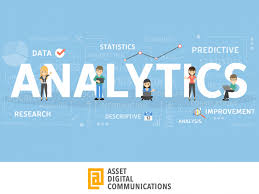the ability to drive traffic to your website and convert that traffic into meaningful business results is the ultimate goal. However, achieving this requires more than just running ads or posting content. It requires digital marketing analysis—a strategic approach to understanding what drives traffic, how visitors behave, and which efforts yield the best returns. By conducting a thorough digital marketing analysis, businesses can optimize their strategies, improve ROI, and achieve better results. In this blog, we’ll delve into the importance of digital marketing analysis and explore how it helps drive both traffic and conversions.
What is Digital Marketing Analysis?

Digital marketing analysis refers to the process of collecting and evaluating data related to online marketing efforts. This data can come from various sources, such as website traffic, social media engagement, email campaigns, paid ads, and more. The goal of the analysis is to understand how effectively your digital marketing strategies are performing, identify areas for improvement, and make data-driven decisions that lead to better traffic generation and higher conversion rates.
Digital marketing analysis encompasses several key components, including:
- Traffic sources (organic search, paid search, social media, referrals, etc.)
- Visitor behavior on your website
- Conversion rates (the percentage of visitors who take a desired action)
- ROI of paid advertising campaigns
- Engagement metrics (likes, shares, comments, etc.)
- Audience demographics and interests
By using tools like Google Analytics, SEMrush, Facebook Insights, and others, you can gather valuable insights and take actions that directly impact your business’s bottom line.
Why is Digital Marketing Analysis Important?
1. Identifying Effective Channels and Strategies

One of the key benefits of digital marketing analysis is that it helps you identify which marketing channels and strategies are driving the most traffic and conversions. For instance, you might find that organic search traffic from SEO efforts is delivering the highest-quality leads, while paid ads or social media campaigns aren’t yielding the same results.
Understanding this allows you to focus your time, energy, and budget on the channels that are performing best. It also helps you identify which strategies might need tweaking or reworking, ensuring that you’re investing in the right areas.
2. Optimizing Conversion Rates

Getting visitors to your website is one thing, but turning them into customers or leads is the ultimate goal. Digital marketing analysis provides insights into how visitors are interacting with your site. By analyzing data on things like bounce rates, average time on site, and page views, you can determine where potential customers are dropping off and why.
For example, if you see that a high number of visitors leave your site after viewing a particular page, it may indicate a problem with the page’s design or content. Perhaps the call-to-action (CTA) isn’t clear, or the page takes too long to load. With digital marketing analysis, you can make adjustments to optimize the user experience and improve your conversion rates.
3. Measuring ROI

Knowing how much revenue your marketing efforts are generating compared to the money you’re spending is crucial for the long-term success of your business. Digital marketing analysis helps you measure the ROI of various campaigns—whether that’s through paid search ads, email marketing, or social media campaigns.
By tracking performance metrics such as cost-per-click (CPC), cost-per-acquisition (CPA), and return on ad spend (ROAS), you can determine whether your marketing campaigns are cost-effective and generating enough value to justify the investment. If a particular campaign isn’t performing well, digital marketing analysis allows you to stop wasting resources and adjust your approach.
4. Understanding Customer Behavior

A key element of digital marketing analysis is understanding how your customers behave online. Analyzing user behavior can help you identify pain points in the customer journey, which can affect both traffic generation and conversion rates. For example, if your website has a high drop-off rate at the checkout page, you may want to investigate the user experience on that page.
Tools like heatmaps and session recordings can show where visitors are clicking, how they navigate through your site, and where they lose interest. By understanding customer behavior, you can create more personalized and targeted marketing efforts that speak to your audience’s needs and preferences.
5. Competitor Insights
Another critical aspect of digital marketing analysis is understanding how your competitors are performing. By analyzing your competitors’ traffic sources, social media activity, and keyword rankings, you can uncover opportunities for your business. Are they targeting keywords you’re missing? Are there gaps in your strategy that you could fill?
This competitive analysis allows you to position yourself more strategically in the marketplace and make smarter decisions on how to drive traffic and conversions. By staying ahead of competitors in both content and SEO, you can give your business an edge and attract more potential customers.
How to Use Digital Marketing Analytics to Drive Traffic
1. Keyword Research and SEO
One of the most effective ways to drive traffic is through search engine optimization (SEO). By analyzing search trends and identifying high-volume keywords, you can optimize your website content for better visibility in search engine results.
Digital marketing analysis tools like Google Keyword Planner and Ahrefs allow you to track keyword performance and discover new opportunities. By identifying long-tail keywords (specific phrases with lower competition), you can attract more targeted traffic to your website.
Additionally, analyzing competitors’ keyword strategies can help you find untapped opportunities and areas where you can rank higher in search results. By focusing on the right keywords and optimizing your content for those keywords, you can attract more relevant traffic to your website.
2. Paid Advertising Performance
Paid advertising (PPC) is another avenue to drive traffic to your website. Digital marketing analysis tools allow you to monitor the performance of your paid campaigns in real-time. With tools like Google Ads and Facebook Ads Manager, you can track key metrics such as click-through rate (CTR), CPC, and conversion rates.
If a particular ad isn’t performing as well as expected, digital marketing analysis lets you optimize your campaigns by testing different ad creatives, adjusting your targeting, or changing your bidding strategy. This constant optimization ensures that your paid advertising efforts remain effective in driving traffic to your website.
3. Social Media Engagement
Social media platforms can also be a great source of traffic. Analyzing your social media campaigns using tools like Facebook Insights or Instagram Analytics allows you to measure the performance of your posts and ads. By reviewing engagement rates, click-throughs, and shares, you can better understand which content resonates with your audience.
Using this data, you can create more engaging social media content that drives users to your website. Whether it’s a blog post, product page, or a special offer, digital marketing analytics helps you tailor your social media strategy to drive traffic effectively.
How to Use Digital Marketing Analytics to Increase Conversions
1. Improving Landing Pages and CTAs
By analyzing visitor behavior on landing pages, you can determine which pages are converting the best and which need improvement. If visitors aren’t engaging with your CTAs, it could mean that the message is unclear or that the CTA isn’t placed strategically.
Digital marketing analytics enables you to test different landing page variations (A/B testing) and optimize elements such as headlines, images, CTAs, and form fields to boost conversion rates. This ensures that you are not only driving traffic but also turning that traffic into valuable leads or customers.
2. Personalizing the User Experience
Personalization is a powerful tool for increasing conversions. By using data from digital marketing analytics, you can segment your audience based on behavior, demographics, and interests. This allows you to deliver tailored content, offers, and recommendations that are more likely to resonate with specific segments of your audience.
For example, if a user has shown interest in a particular product category, you can retarget them with relevant ads or personalized email campaigns to encourage them to complete a purchase.
3. Optimizing the Sales Funnel
A key aspect of digital marketing analytics is tracking how visitors move through your sales funnel. By understanding where users drop off in the funnel, you can take corrective action. If visitors abandon their carts at checkout, you may want to simplify the checkout process or offer an incentive, such as free shipping, to close the sale.
Using data from digital marketing analytics, you can refine and optimize each step of the customer journey to ensure a seamless transition from visitor to paying customer.
Conclusion
Digital marketing analytics is a powerful tool for driving traffic and increasing conversions. By leveraging data to understand where your traffic is coming from, how visitors behave on your website, and which marketing strategies are most effective, you can optimize your campaigns for maximum performance. Whether you’re focusing on SEO, paid advertising, or social media marketing, digital marketing analytics helps you make data-driven decisions that lead to better results, improved ROI, and business growth. By continually analyzing your efforts and adapting to trends, you can stay ahead of the competition and ensure long-term success.
Also Read :How to Start a Marketing Firm: Your Guide to Building a Thriving Business

